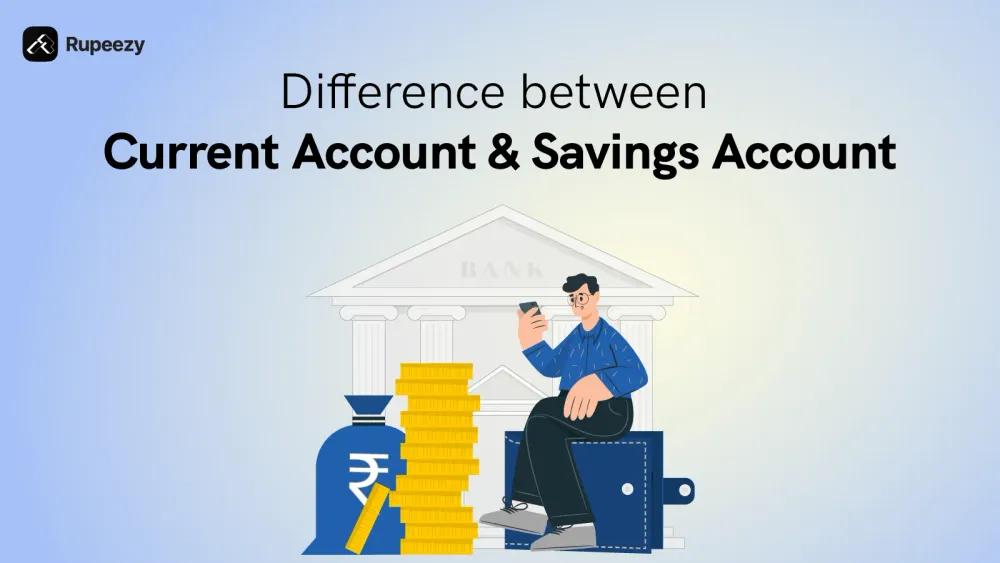Difference between Current Account and Savings Account


00:00 / 00:00
You must have heard that individuals open savings accounts while businesses need a current account. While this gives you the basic difference between a current account and a savings account, there is more to it.
Well, there are numerous questions around them. From understanding these accounts to exploring savings accounts vs current accounts, get all the details here. But before that, let us understand these two accounts and their features.
What is a Savings Account?
A savings account is a bank account designed to hold money securely while earning interest. It offers a safe place to deposit funds and provides easy withdrawal access, making it ideal for short-term savings goals or emergency funds.
Unlike some investment options, savings accounts prioritize liquidity, allowing you to access your money when needed. Interest rates, while typically modest, help your balance grow over time.
Savings accounts are a foundational tool for personal finance, encouraging responsible saving habits and providing a convenient way to manage your money. They are often insured by government entities, further ensuring the safety of your deposits.
Eligibility and Documents for Savings Account
To open a savings account, you typically need to be an Indian resident (though accounts are also available for non-residents). Minors can also open accounts, often with a parent or guardian. Banks may have specific requirements, but generally, you must meet KYC (Know Your Customer) norms.
The documents that you would need to share are:
Document Type | Accepted Documents |
Proof of Identity | Aadhar Card, PAN Card, Passport, Voter ID Card, Driving License |
Proof of Address | Aadhar Card, Passport, Utility Bills (recent), Bank Statement |
Photographs | 2-3 Passport-sized Photographs |
PAN Information | PAN Card (or Form 60 if PAN not available) |
Features of a Savings Account
Now that you know what a savings account is let us understand its primary features. So, here are the primary features that you must be aware of:
Earn interest on your account balance, typically around 4.00%.
Senior citizens may receive an additional interest rate benefit.
Enjoy high liquidity, allowing unlimited withdrawals and transfers.
Receive a debit/ATM card for convenient payments, online transactions, and cash withdrawals.
Transfer funds using UPI, NEFT, IMPS, or RTGS through net banking, mobile banking, or by visiting the bank branch.
Manage your account through various channels such as net banking, mobile banking, phone banking, or SMS banking.
Generally, there are no limits on the amount that can be deposited in the savings account.
Bank deposits are insured up to Rs.5 lakh by the DICGC for added security.
Link your savings account with fixed deposit accounts for better interest rates.
Choose how you receive interest payments: monthly, quarterly, semi-annually, or annually.
Easily deposit or receive cheques directly through your savings account.
Benefit from features like auto-sweep facilities that transfer excess funds to fixed deposits for higher returns.
Mobile alerts and notifications for transaction updates and account activity.
Benefits of Savings Account
So, here are the benefits of opening a savings account:
Security & Stability
A savings account provides a safe and secure place to keep your money. Your deposits are often insured, offering peace of mind and a solid foundation for your financial future.
Earn Interest
Your money grows over time thanks to the interest you earn on your savings account balance. This provides a small but steady return on your deposited funds.
Added Benefits
Many savings accounts come with added perks and benefits, such as discounts, rewards programs, and other special offers. These can enhance the value of your account beyond just saving money.
Financial Discipline & Growth
Opening a savings account can help you develop better financial habits. Regularly contributing to your savings encourages responsible spending, smart budgeting, and a long-term perspective on your financial well-being.
Convenient Money Management
Managing your money is simpler than ever with a savings account. Online and mobile banking tools let you easily track your balance, pay bills, transfer funds, and monitor your transactions, all from the convenience of your phone or computer.
Perfect for All People
Savings accounts are beneficial for individuals of all ages and financial backgrounds. They provide a simple and accessible way to save money and build a more secure financial future, regardless of your starting point.
With this, you have all the details linked to the savings account. Bure before we explore savings vs current account, let us find the details of the current account here.
What is a Current Account?
A current account is for businesses and companies. This account helps in managing business transactions easily. It helps with making payments to vendors and receiving payments from customers.
Compared to a savings account, this offers additional benefits. Though the interest offered is zero, the transaction limit is high. You also get the added business benefits which help in managing business better.
Current accounts help in seamless financial operations and contribute to overall efficiency. This is essential to maintain a healthy flow of money.
Eligibility and Documents for Current Account
Current accounts are designed for businesses and organizations, including:
Sole proprietorships
Partnership firms
Limited Liability Partnerships (LLPs)
Companies (private and public).
The documents that you need to open a current account are as follows:
Business Type | Key Documents Required |
Sole Proprietorship |
|
Partnership Firm |
|
Limited Liability Partnership (LLP) |
|
Company (Pvt. Ltd. & Public Ltd.) |
|
Features of a Current Account
Now that you know what a current account is let us understand its primary features. So, here are the primary features that you must be aware of:
Conduct a high volume of transactions to smoothly manage your business operations.
Access an overdraft facility to meet your financial needs.
Make payments via cheque, online transfers (NEFT, RTGS, IMPS), UPI, and other methods for flexible transactions.
Enjoy higher cash deposit limits compared to savings accounts, accommodating cash-intensive businesses.
Receive multiple free chequebooks for easy payments.
Access and manage accounts via online and mobile banking.
Make payments online with no hassle.
Bulk payment options to save time.
Trade finance services such as letters of credit and export-import financing for international trade.
Integrate with payment gateways to accept online payments from customers.
Dedicated relationship manager to help you.
Automatically transfer funds between your current and linked accounts to optimize liquidity and returns.
Generate customized reports on your account activity to track expenses and monitor cash flow.
Obtain business credit cards easily.
Get Point of Sale (POS) solutions for your business expansion.
Collection and loan services are also there.
Benefits of Current Account
Understanding current account vs savings account is incomplete until you know the benefits of using the current account. The main benefits are:
Seamless Transactions
With a current account, you can manage high-value transactions easily. They have higher limits, and so the chances of penalties are less. You can manage your receivables and payables effectively. This will help in boosting your business.
Overdraft Facility
Getting additional funds for business is easy. This is usually through the overdraft facility. This helps in managing capital workflow. this helps in running the business smoothly.
Efficient Cash Management
Current accounts provide tools for effective cash management. You can easily check the inflows and outflows. You can link it to your overdraft account. this will help meet daily funding needs easily.
Convenient Payment Options
Businesses can make and receive payments through various channels. All can be tracked online, which saves time. This helps in managing funds better. This flexibility ensures that businesses can transact efficiently.
Access to Business Services
Current accounts offer add-on services, too. You can get a debit card as well. Additionally, if you look for expansion, you can get the loans too. Further, there is a facility for payments and salary services. Services for international expansion are also there.
Digital Banking Solutions
You can use the internet or mobile banking. This can save time and can help you manage your business transactions from anywhere. Hence, it's key to helping your business grow.
Customized Account Options
Banks offer a host of Current Account variants. You can select the one that suits your needs. This helps you with better services. Also, this way, you can manage your funds better by setting your minimum balance needs.
Current accounts can help business owners greatly. With this, you now know all the details linked to the same. Now, it's time to explore saving and current account differences.
Difference Between Saving Account And Current Account
Till now, we have explored both accounts in detail. So, now let us explore savings account vs current account here.
Feature | Savings Account | Current Account |
Purpose | It aims to help you save money. | It helps you to manage your daily business transactions. |
Suitable for | It is best suited for individuals. People of all ages can open it. | It is for businesses of all types. It can by opened by startups or large-scale businesses alike. |
Interest | This account offers you a rate of interest on your savings. It can be monthly, quarterly, or yearly. | There is no interest offered on the account. |
Transaction Limits | There is a limit to transactions. After this, there will be fee charges. | Generally, there is no limit. This is to ensure the business runs smoothly. |
Overdraft Facility | Generally, there is no such feature associated. | It allows you to link overdraft accounts for better fund flow. |
Minimum Balance | There is a lower minimum balance needed. If this is not met, there will be a penalty. | The balance needed is usually high or sometimes zero. There are charges for non-maintenance. |
Accessibility | It can be accessed online or offline. Transaction limits are there here too. | The same can be used online or offline. At times, dual verification is needed. |
Maintenance Fees | The maintenance fee is usually low. | The charges are usually high. |
Opening Process | The process is quite simple. You need to submit the basic KYC and form. | There is a high documentation need. The time needed is high too. |
Conclusion
With this, you now have a clear idea of the difference between saving and a current account. Both these accounts are offered by the banks but serve different categories of customers.
Where savings accounts are for individuals, current accounts are for businesses. Choosing the right account depends entirely on your specific financial objectives and transaction needs. If you are an individual looking to save, a savings account is your best bet. If you are a business owner managing daily transactions, a current account is the ideal choice.
So, if you are looking to open an account, ensure to check all its features and offerings. Knowing your current vs savings account will help you to start your planning on the right track. So, what wait? Open your account today and get your financial journey started!
FAQs
Q. What's the key difference between a savings and a current account?
A savings account is mainly for individuals who want to save money and earn interest on it. It’s great for personal savings. A current account is tailored for businesses and professionals who need to manage frequent transactions without earning interest.
Q. Who should use a savings account versus a current account?
Savings accounts are perfect for people who want to grow their savings safely. Current accounts are ideal for business owners and organizations that need to handle lots of transactions regularly.
Q. Can a savings account be used for business transactions?
It's not recommended because savings accounts have transaction limits and penalties for exceeding them. They're meant for personal use.
Q. What benefits does a current account offer to business owners?
A current account supports frequent and large transactions, provides an overdraft facility, and helps in efficient cash management, making it essential for daily business operations.
Q. Is there a minimum balance requirement for these accounts?
Yes, savings accounts usually require a lower minimum balance, while current accounts might have higher or zero minimum balance requirements, depending on the bank’s policy.
Check Out These Related Articles |
The content on this blog is for educational purposes only and should not be considered investment advice. While we strive for accuracy, some information may contain errors or delays in updates.
Mentions of stocks or investment products are solely for informational purposes and do not constitute recommendations. Investors should conduct their own research before making any decisions.
Investing in financial markets are subject to market risks, and past performance does not guarantee future results. It is advisable to consult a qualified financial professional, review official documents, and verify information independently before making investment decisions.

All Category










